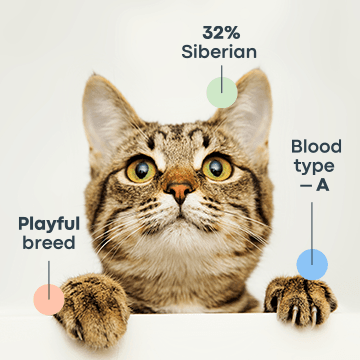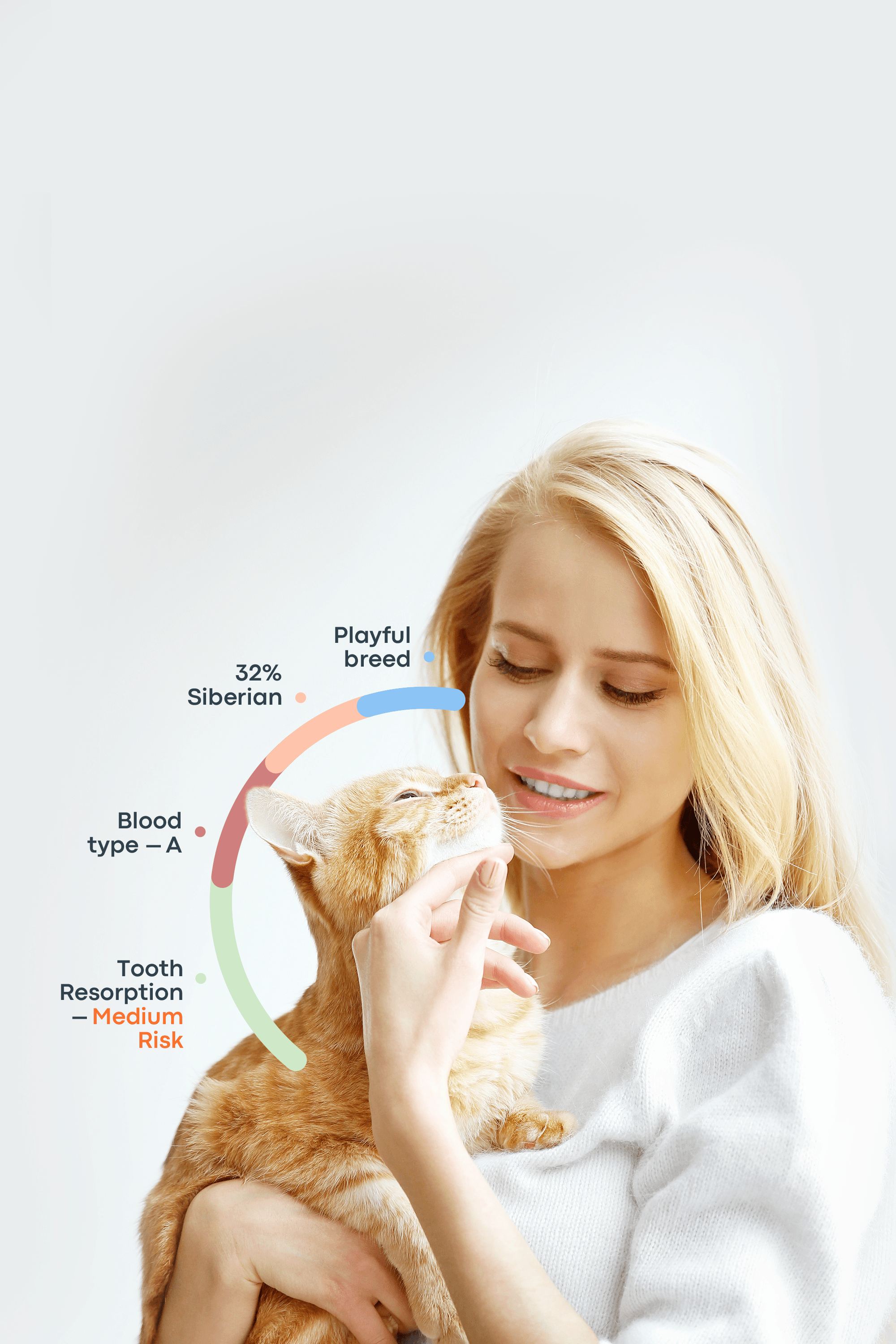As cat owners, we strive to keep them happy, full of vigor, and, most of all—healthy. However, when cats become unwell, it is distressing and challenging to know the cause. Bacterial infections in cats are one of the common problems, yet mostly overlooked. The disease may range from mild to severe. When untreated, it can significantly affect your cat's quality of life.
There are different ways that a bacterial infection can manifest—from a localized skin irritation to a more systemic manifestation, affecting organs like the respiratory system and urinary system. Some symptoms are subtle and easy to miss, but others escalate quickly, leading to complications and discomfort. We will discuss the symptoms, common causes, preventive measures, and available treatments to empower you as a cat owner and ensure you provide your cat with the best possible health.

What Is a Bacterial Infection?
Bacterial infections in cats are concerning conditions caused by microscopic organisms found everywhere—on the skin, in other animals, and even inside the cat's body. ‘Bacteria’ is a term that often may mean negative for some, but it must be understood that not all bacteria are harmful. Some help maintain balance and health, such as aiding digestion and supporting the immune system.
Bacteria are microorganisms that can be harmful (pathogenic) or non-harmful (non-pathogenic). A bacterial infection occurs when pathogenic bacteria enter the body, multiply, and disrupt normal bodily functions. This can happen in cats' skin, respiratory, digestive, or urinary tract systems. The infection may worsen if the body cannot fight the bacteria, leading to symptoms requiring medical attention.
Bacterial infections commonly diagnosed in cats
There are many different bacteria that can cause disease in felines. Following is a table created by RRDA with an overview of the common bacterial infections in cats:

Bacterial pathogens causing disease in cats most commonly belong to the following genuses: Staphylococcus, Salmonella, Escherichia, Campylobacter, Clostridium, Toxoplasmosis, Chlamydophila, Pyodermas, Actinomyces, Spirochete, Fusobacterium, Bartonella and others. Because of the severity of the disease they cause, three of the most famous species of bacteria pathogenic to cats are Mycoplasma haemofelis, Yersinia pestis and Bartonella henselae.
How Bacterial Infections Occur and Spread
Bacterial infections can develop when the body's defenses are overwhelmed. Several things can cause this, such as a weak immune system, prolonged exposure to unhygienic conditions, or a concomitant injury. For example, a wound or cut allows bacteria to enter the skin, causing localized infection. If this is not contained, it may become systemic and infect other organs. Bacterial infections can also spread through direct contact, bites or scratches, ingestion, and environmental exposure.
Harmful vs. Beneficial Bacteria
Bacteria are complex and highly diverse, and their interaction with the cat's body can have positive or adverse effects. Harmful bacteria are often the focus when we talk about infections. But it's also important to recognize that beneficial bacteria help maintain your cat's health.
In healthy cats, beneficial bacteria compete with harmful ones, maintaining the balance of the internal environment. However, some conditions disrupt this balance, and it can be in the form of illness, poor diet, antibiotic use, or stress. This disruption can cause harmful bacteria to gain the upper hand, causing infections. For example, a cat recovering from an illness may already have a weakened immune system, making it easier for pathogenic bacteria to cause disease.
Common Types of Bacterial Infections in Cats
A range of pathogens can cause bacterial infections in cats. Each of these pathogens presents unique challenges to your cat's health. There are cat bacteria that start with a T, like Toxoplasma gondii, which is an intestinal parasite. Other bacteria affect cats only, while others have zoonotic risks, which means they can spread the disease to humans. A perfect example is the T. gondii mentioned earlier. Key bacteria, such as Staphylococcus, Salmonella, and Bartonella henselae, must be understood for effective prevention and treatment.
Staphylococcus
Staphylococcus bacteria are a common cause of skin infections in cats. They often occur when the skin is not intact or is injured. Scratches, cuts, or surgical wounds create openings for these bacteria to invade underlying tissues, leading to localized infections. Cats with Staphylococcal infections may have swelling, redness, abscesses, or hair loss. In severe cases, it could result in fever or more systemic issues. The zoonotic risk for Staphylococcus is low, but humans—having the same bacteria on their skin—may occasionally develop infections through direct contact. If you care directly for your cat, maintain proper hygiene, such as handwashing, especially after handling an infected pet.

Salmonella
Salmonella is associated primarily with gastrointestinal conditions in cats, often contracted through the consumption of contaminated prey, water, or food. Symptoms of Salmonella infection include diarrhea, vomiting, lethargy, and fever. In severe cases, it could lead to systemic infections and dehydration. Salmonella poses a zoonotic risk, which makes it a particularly important bacteria for cat owners. Humans with underlying conditions, the immunocompromised, elderly people, or children can come in contact with an infected cat's feces or other contaminated surfaces and get infected. Ensuring proper food handling, cleaning litter boxes regularly, and keeping the infected cats isolated are just some ways to reduce the risk of transmission.
Bartonella henselae
Bartonella henselae is the agent that causes Cat Scratch Disease (CSD). It poses a significant zoonotic risk since this is one of the cat bacteria that is hard to detect. Some infected cats show no symptoms, while others may develop fever, fatigue, and swollen lymph nodes. The primary carrier for Bartonella henselae is a flea, which transmits the infection to cats through bites or exposure to flea feces. Humans can get Cat Scratch Disease through bites or scratches from an infected cat. It can cause fever, swollen lymph nodes, and fatigue in humans. Immunocompromised hosts like children and older adults are particularly at higher risk for this disease. It is essential to have effective flea control and routine veterinary check-ups to prevent the spread of disease.
Symptoms of Bacterial Infections in Cats
Recognizing the symptoms of bacterial infections is crucial for early diagnosis and intervention. The symptoms may vary depending on the type and where the disease occurs. For example, a bacterial infection in the stomach may have different symptoms than those in the lungs. Symptoms are categorized into general, infection-specific, and behavioral changes to make it easier.
General Symptoms
Cats with infections often manifest symptoms indicating something is wrong. It may include appetite loss, fever, and lethargy. For example, a previously active cat may spend the entire day sleeping or refusing to engage in playtime. This change often signals that a bacterial infection may affect your cat's well-being.
Infection-Specific Symptoms
There are also infection-specific symptoms, which may make associating with a specific type of infection easier. For example, skin infections caused by Staphylococcus may cause visible redness, swelling, or abscesses. Respiratory infections caused by Bordetella bronchiseptica may lead to difficulty breathing, sneezing, nasal discharge, and coughing. Infections caused by Salmonella may produce gastrointestinal symptoms like diarrhea, vomiting, and dehydration. In contrast, infections caused by E. coli may lead to symptoms consistent with urinary tract infections, such as frequent urination, blood in the urine, or straining in the litter box. Pay close attention to these symptoms to ensure proper and timely management.
Behavioral Changes
There are also behavioral changes associated with bacterial infections. Cats with discomfort and pain may become irritable, withdraw from affection, or react aggressively when touched. They may also seek quiet and dark spaces or hide more frequently. You may also observe excessive grooming if they have skin-related infections.
Causes and Risk Factors
Various factors predispose cats to bacterial infections. These conditions can be external or internal. Recognizing these factors allows you to protect your feline friend proactively. Examples of such factors include age, environmental conditions, and health status.

Contributing Factors
Age is a major contributing factor. Kittens and senior cats are at risk because of their immune status. Kittens still have underdeveloped immune systems, while senior cats may be experiencing a natural decline in their immune function. This status predisposes them to various infections. For example, older cats suffering from chronic conditions like kidney problems may be more prone to E.coli-related urinary tract infections.
Weak immune systems due to undernutrition or illness are another significant risk factor. For example, cats recovering from a recent viral infection like feline immunodeficiency virus (FIV) are at increased risk since their immune systems are already compromised. In the same manner, undernutrition leaves cats unable to fight off infection.
Environmental and Behavioral Risks
Environmental and behavioral risks are external factors significantly increasing the risk of cat infections. Cats frequently exposed to other infected animals are more likely to get bacteria like Bordetella bronchiseptica or Salmonella. Therefore, correct isolation of infected animals and regular veterinary visits to reduce such risk are crucial.
Another factor is poor hygiene, like dirty litter boxes, contaminated water or food bowls, and an unsanitary environment. These factors often create an opportunity for bacteria to breed. So, maintaining a clean environment for cats, including clean bedding, litter boxes, and bowls, is crucial to prevent infections.
Examples of behavioral risk include the tendency to fight with other animals, which may lead to bacterial infections. Frequent involvement in fights may increase the risk of bite wounds, which may later lead to infection with bacteria like Pasteruella multocida. Preventing these situations can prevent the risk of injury and subsequent infection.
Diagnosis of Bacterial Infections
Diagnosing cat bacterial infection requires different approaches, including observation, professional help, and diagnostic testing. Timely diagnosis allows for early intervention, preventing complications in the process. So, how do we diagnose bacterial infections in our feline friends?
Veterinary Examination
Veterinary consultation is the first and the best way to diagnose bacterial infections. A comprehensive physical exam assesses if the cat has any visible signs of infection like discharge, swelling, or abscesses. A detailed history of symptoms and observations, such as appetite and behavioral changes or decreased energy levels, will help narrow down the possible causes. It will direct the veterinarian to decide on what to do next.
Diagnostic Tests
Diagnostic tests are requested and performed to confirm the presence of bacterial infection and possibly identify the specific organism causing it. There is a range of diagnostic tests that a veterinarian may request. Blood tests, for example, may reveal blood abnormalities, such as elevated white blood cell counts. Culture from different samples like saliva, urine, or discharge from wounds is another method often used when there is a need to identify the specific bacteria. Conversely, a biopsy is done mainly in skin-related infections that allow the veterinarian to examine a tissue under a microscope. Other tests include sensitivity testing to identify which antibiotic will work best against the bacteria.
Why Early Diagnosis Matters
Early and timely diagnosis is crucial to prevent complications and ensure a smooth recovery from the disease. Bacterial infections could also spread to other parts of the cat's body when left untreated. This may lead to more severe issues like organ damage, sepsis, or chronic infections.
Treatment Options
Dealing with animal infections requires appropriate treatment to ensure a speedy recovery and prevent further escalation of the problem. Your veterinarian may choose several treatment options depending on the type of infection being treated.
Antibiotics
Feline antibiotics play a critical role in fighting off bacterial infections. It targets harmful microorganisms, thus supporting the cat's body to fend off the infection. However, the improper use of antibiotics can also lead to another problem, such as your cat not responding to antibiotic treatment or antibiotic resistance. To prevent this from happening, it is crucial to follow the veterinary prescription and ensure that the cat completes the required duration of treatment.
Topical Medications
Topical treatments are another treatment option, which is more commonly used against skin infections or surface-level wounds. Ointments, medicated shampoos, and sprays have been formulated to treat localized infections. Using these local treatments as directed is essential to ensure they will work and facilitate healing.
Pain and Fever Management
Infections are often associated with pain or fever, which adds discomfort for your feline friend. Anti-inflammatory and analgesic medications are available and prescribed to alleviate this discomfort and facilitate recovery. As always, follow the direction of your veterinarian to avoid under- or overdosing your cat.
Specialized Treatments
In severe cases, specialized treatments are carefully planned to address the leading cause of the infection. For example, in abscesses, surgical drainage and cleaning ensures the wound is adequately cleaned, thus preventing the spread of disease. This type of intervention must be done by a professional only so that it serves its primary purpose of promoting faster healing and preventing complications.
Prevention Strategies
Preventive strategies are always better than treating infections. It allows our pets to live comfortably and reduces your vet expenses. Here are some practical strategies you can maintain:
Hygiene Practices
Keeping a clean environment for your pet is critical to prevent infections. Food and water bowls must also be kept clean to avoid bacterial breeding. Litter boxes must be cleaned frequently as they can harbor many infectious organisms, causing gastrointestinal or urinary issues. Washing your pet's bedding and washing grooming tools and toys are additional steps to minimize exposure to harmful bacteria.
Routine Veterinary Care
Regular check-ups and vaccinations are critical aspects of preventive care. Vaccinations allow a cat's immune system to fight diseases like feline panleukopenia or canine parvovirus. Having an updated vaccination status offers constant protection against serious infections. On the other hand, routine veterinary visits provide opportunities to diagnose any problems early and prevent complications.
Strengthening Immunity
A strong immune system is necessary to defend against infections naturally. To strengthen the immunity, proper nutrition is required. It provides the essential nutrients, minerals, and vitamins to maintain optimal health. Their diet should include high-quality protein, balanced vitamins, and healthy fats. Additionally, your vet may suggest supplements like omega-3 fatty acids, immune-boosting minerals, and probiotics. Regular exercise must also be a part of the cat's routine.
Avoiding High-Risk Situations
Minimizing exposure to high-risk situations is also one of the preventive strategies that help reduce infections. Keep your cat indoors as much as possible, as this will lead to unnecessary exposure to other animals. Avoid unsanitary places, such as crowded shelters or areas frequented by stray animals.
Recovery and Aftercare
Recovery and aftercare are essential steps, especially after a recent infection. It focuses on helping your pet fully recover, avoid complications, and reduce the risk of future infections.
Wound Management
Pets recovering from surgical procedures should receive proper wound care. Your vet will instruct you on how to clean the wound using saline or other prescribed antiseptic solutions. You also have to keep the wound dry and protected from dirt. If bandages are used, they must be changed regularly and inspected for signs of discharge. They should also be checked for signs of swelling or redness. An Elizabethan collar or protective clothing prevents your cat from licking or scratching the wound.
Post-Treatment Monitoring
Close monitoring of your pet after treatment is essential to ensure the infection has subsided and will not recur or cause further complications. Post-treatment monitoring will include observing for new or lingering symptoms. You should also confirm that the entire course of antibiotics has been completed, even if the pet already shows signs of improvement.
Preventing Licking and Scratching
It is crucial to keep your pet from licking and scratching, which may reopen wounds and introduce bacteria. If the wound is reinfected, it will delay the healing process. E-collars, recovery suits, and vet-approved bitter sprays are available to discourage this behavior. Distract your pet with enrichment, like interactive puzzles or toys, to reduce their anxiety.
Preventing Future Infections
You must take proactive steps to prevent future infections or reinfections once your pet has recovered. Give them adequate nourishment, get regular exercise, and manage their stress. You should also maintain good hygiene practices, like cleaning, grooming tools, and washing the cat's bedding. You should also schedule routine visits with the veterinarian to keep your cat's vaccination up-to-date and other parasite-prevention treatments.
Creating a Comfortable Healing Environment
Create a calm and safe space for your cat because this is a must during the recovery period to promote healing and reduce stress. This environment helps your pet rest properly, avoid unnecessary stress, and recover more effectively from infections or medical procedures.
Other ways to create a comfortable healing environment include limiting outdoor exposure to reduce the risk of reinfection or exposure to more pathogens. Designate a recovery area where the cat can stay in a quiet, free, and clean environment.
Importance of Follow-Up Appointments
Sticking to the follow-up schedule is crucial during the recovery period. This ensures your pet is healing and there are no complications. The follow-up check-up allows your veterinarian to assess the healing progress, remove stitches if the pet has undergone surgery, and deal with lingering concerns. The follow-up schedule is significant if your pet has been treated for particularly severe and chronic conditions. During the follow-up, the vet may request diagnostic tests necessary to confirm whether the infection has fully resolved.
Conclusion
It can be overwhelming to care for your cat when they are infected. But, with the correct information and knowledge, you can take proactive steps to treat bacterial infections. Bacterial infections are not necessarily a cause for excessive worry. It is often preventable and will not cause severe issues once identified and treated early. Hygiene, regular vet visits, and boosting your cat's immune system are just some steps to reduce the risk of bacterial infections.
Frequently Asked Questions
How serious is bacterial infection in cats?
Bacterial infections in cats may range from mild to life-threatening conditions. It depends on the type and severity, which requires prompt veterinary attention for correct diagnosis and treatment.
What are the signs of an infection in an older cat?
Older cats may show signs of fever, loss of appetite, lethargy, visible swelling or discharge from a wound, or difficulty breathing. They may show reduced grooming and other behavioral changes.
Can bacteria in cats' saliva cause infections in humans?
Yes, some bacteria, present in cats' saliva, like Pasteurella multocida, can cause infection in humans if bitten or scratched. Practicing good hygiene and prompt treatment of wounds can minimize this risk.
How did my indoor cat, who hasn't been around animals, get a respiratory infection?
Indoor cats, even when they aren't exposed to animals, can still get respiratory infections through airborne pathogens, contaminated surfaces, or humans who carry bacteria and viruses in their clothing.
Do kittens get upper respiratory infections from their mothers?
Yes, kittens can get upper respiratory infections from their mothers, specifically if the mother is infected or carrying a viral or bacterial infection during grooming or nursing.
Why do indoor cats (and kittens) get infections in their eyes and mouths so frequently?
Indoor cats often get eye and mouth infections from exposure to bacteria or viruses that persist in their environment. Kittens have weakened immune systems, which predisposes them to infections. Stress can also make them more vulnerable.









